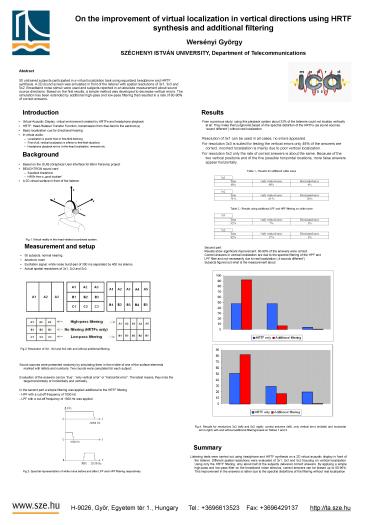1. dia - PowerPoint PPT Presentation
Title: 1. dia
1
Abstract 50 untrained subjects participated in a
virtual localization task using equalized
headphone and HRTF synthesis. A 2D sound screen
was simulated in front of the listener with
spatial resolutions of 3x1, 3x3 and 5x2.
Broadband noise stimuli were used and subjects
reported in an absolute measurement about sound
source directions. Based on the first results, a
simple method was developed to decrease vertical
errors. The simulation has been extended by
additional high-pass and low-pass filtering that
resulted in a rate of 80-90 of correct answers.
Introduction
Results
- Virtual Acoustic Display virtual environment
created by HRTFs and headphone playback - HRTF Head-Related Transfer Function,
transmission from free-field to the eardrum(s) - Basic localization cue for directional hearing
- In virtual audio
- Localization is poorer than in free-filed
listening - First of all, vertical localization is inferior
to free-field situations - Headphone playback errors in-the-head
localization, reversals etc.
From a previous study using this playback system
about 33 of the listeners could not localize
vertically at all. They make their judgments
based on the spectral distortion of the HRTFs (as
sound sources sound different) without real
localization. Resolution of 3x1 can be used in
all cases, no errors appeared. For resolution
3x3 is suited for testing the vertical errors
only 48 of the answers are correct, incorrect
localization is mainly due to poor vertical
localization. For resolution 5x2 only the rate
of correct answers is about the same. Because of
the two vertical positions and of the five
possible horizontal locations, more false answers
appear horizontally.
Background
- Based on the GUIB (Graphical User Interface for
Blind Persons) project - BEACHTRON sound card
- Equalized headphone
- HRIRs from a good localizer
- A 2D virtual surface in front of the listener
Fig.1. Virtual reality in the head-related
coordinate system.
Measurement and setup
Second part Results show significant
improvement 80-90 of the answers were
correct. Correct answers in vertical localization
are due to the spectral filtering of the HPF and
LPF filter and not necessarily due to real
localization (it sounds different) Subjects
figured out what is the measurement about
- 50 subjects, normal hearing
- Anechoic room
- Excitation signal white noise burst-pair of 300
ms separated by 400 ms silence. - Actual spatial resolutions of 3x1, 3x3 and 5x2.
Fig.2. Resolution of 3x1, 3x3 and 5x2 with and
without additional filtering.
Sound sources were presented randomly by
simulating them in the middle of one of the
surface elements marked with letters and numbers.
Two rounds were completed for each subject
. Evaluation of the answers can be true, only
vertical error or horizontal error. The latest
means, they miss the target horizontally or
horizontally and vertically. In the second part
a simple filtering was applied additional to the
HRTF filtering - HPF with a cut-off frequency of
7000 Hz - LPF with a cut-off frequency of 1500
Hz was applied
Fig.4. Results for resolutions 3x3 (left) and 5x2
(right) correct answers (left), only vertical
error (middle) and horizontal error (right) with
and without additional filtering based on Tables
1 and 2.
Summary
Listening tests were carried out using headphone
and HRTF synthesis on a 2D virtual acoustic
display in front of the listener. Different
spatial resolutions were evaluated of 3x1, 3x3
and 5x2 focusing on vertical localization. Using
only the HRTF filtering, only about half of the
subjects delivered correct answers. By applying a
simple high-pass and low-pass filter on the
broadband noise stimulus, correct answers can be
biased up to 80-90. This improvement in the
answers is rather due to the spectral distortions
of the filtering without real localization
Fig.3. Spectral representation of white noise
before and after LPF and HPF filtering
respectively.































